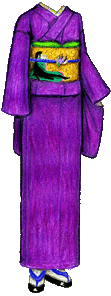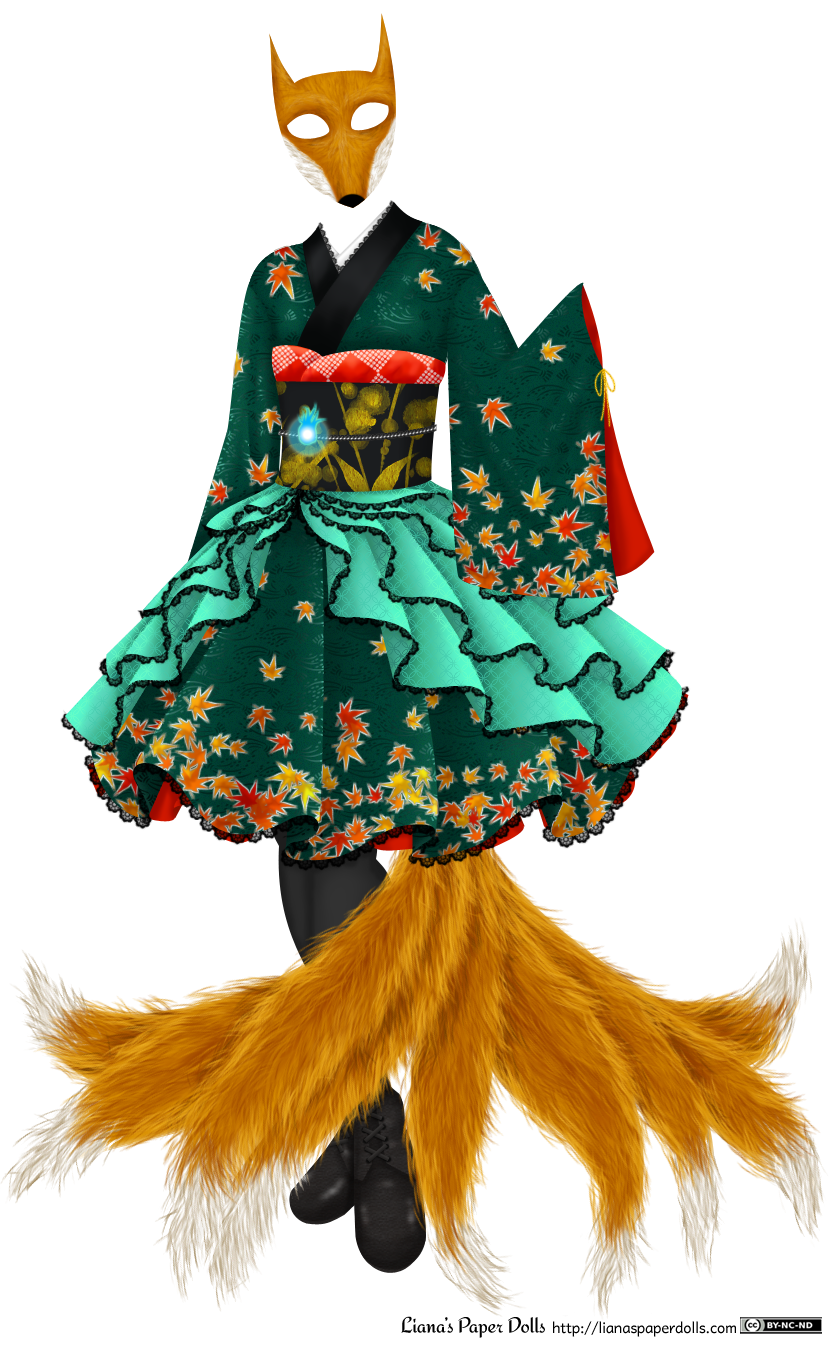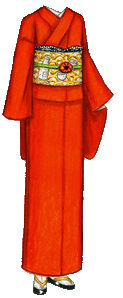 Click for larger version (PNG); click for PDF version. Click here for the list of dolls.
Click for larger version (PNG); click for PDF version. Click here for the list of dolls.
As I wrote back in February, when I drew a poppy red kimono and treated you to stories of red dye made out of mythical creature blood, I have been learning about Japanese color words from a couple of books, Kimono and the Colors of Japan: The Kimono Collection of Katsumi Yumioka and 日本の伝統色 The Traditional Colors of Japan. (More for my own amusement than for any practical purpose, as usual.) This is the second post in the series; I asked you (or rather, my readers in February) to choose the next color and Salvia Blue seemed to be the next winner but at the last minute Iris pulled ahead.
Iris (菖蒲色, ayame-iro) is a literal color name: the word 菖蒲 (ayame) means “iris,” so paired with the kanji for “color,” 色 (iro), the name really is “iris-color.” To be specific, ayame refers to one type of iris that grows in Japan, althouh there are two other common types as well, the 花菖蒲 (hanashōbu) and the 杜若 (kakitsubata), both of which have their own symbolic meanings; the situation isn’t helped by the fact that the words have apparently shifted over time, so that the fragrant ayame beloved by aristocrats a thousand years ago isn’t actually the ayame Japanese people know today. (For more on this shift, read this chapter from Liza Dalby’s memoir: bitter herb grows tall.) Nor is it helped by the fact that the same kanji, 菖蒲, can also be read shōbu — which is both another kind of iris and a shortened form of 花菖蒲 (hanashōbu). This iris-related confusion even prompted a proverb, いずれ菖蒲か杜若 (izure ayame ka kakitsubata), which literally means “Either the ayame or the kakitsubata“; the meaning is something like, “Both of these things are so overwhelmingly beautiful that there’s no point in trying to compare or differentiate between them.” It seems to be rather old-fashioned, and most often applied to pretty women or girls. “Which of those two sisters is more beautiful?” “Well, it’s like the ayame and the kakitsubata.” (For more information: Origami Volume 6: Iris (in English), いずれ菖蒲か杜若 (in Japanese), and a great deal of discussion on Twitter in Japanese with my friend Arietty I can dig up for anyone who’s really interested.)
Ayame-iro is a lovely rich, warm purple with reddish undertones. According to The Traditional Colors of Japan, the hex code for ayame-iro is #6F3381. The Prismacolor Digital Color Coordinator says that the closest single Prismacolor pencil is Mahogany Red, which shows the limits of the tool because that one is far too red. I’m seeing Dark Purple as being closer, but I think it is just a shade too red as well. Dark Purple over a light backing of of Violet is, I think, about right. Interestingly, some sources make a distinction between 菖蒲色 (ayame-iro) and 菖蒲色 (shōbu-iro). For example, this page lists shōbu-iro as a darker purple and ayame-iro as a light lilac.
According to “The Iris Garden at Horikiri,” at the time that article was written (1903), irises were regarded as beautiful, but not particularly emblematic of womanly modesty and virtue, unlike other flowers such as plum blossoms; the name “Ayame” therefore was used by geisha more often than by other women. One of my Japanese friends thought it still might have some geisha-ish overtones, although the first word it reminded her of was the decidedly unauspicious, although unrelated 殺める (ayameru; to murder or to wound). Still, she could think of one kid she knew of with the name, so although it seems uncommon it’s not entirely unused.
There was a famous historical Ayame: Ayame no Mae (菖蒲前), a court lady during the late Heian period (the 1100s). One day, the famous warrior Minamoto no Yorimasa (源頼政) caught a glimpse of her and fell in love with her, but she turned away all her suitors, and for three years his poems and letters went unanswered. The situation came to the Emperor’s attention, and he tested Yorimasa’s love by having Lady Ayame and two other court ladies appear in front of him, all dressed alike. If Yorimasa could pick her out, he could have her. But in those days, noble women kept themselves hidden from men, and Yorimasa had never actually seen his beloved face-to-face. Completely at a loss, he replied with a poem:
五月雨に
沢辺の真菰
水越えて
いずれ菖蒲と
引きぞ煩う
(samidare ni / sawabe no makomo / mizu koete / izure ayame to / hikizo wazurau)
Now, in Yei Theodora Ozaki’s telling of the tale, the poem is translated “In the rainy season when the waters overflow the banks of the lake, who can gather the Iris?” “The rainy season” refers to Yorimasa’s three years of disappointment, and the waters the many tears he had shed, so many that he couldn’t see clearly enough to discern the true Lady Ayame; this response was so modest and admirable that the Emperor took Lady Ayame by the hand and gave her to Yorimasa personally. In the version Anne Dyer tells, it is translated as follows: “When the June rains flood the pond, how impossible it is to distinguish the beautiful Ayame from common reeds!” The real Lady Ayame was embarrassed by this response, and blushed, allowing Yorimasa to pick her out of the lineup!
Incidentally, I am really into the poetry-filled beauty of the Heian period, but when it starts getting into the Genpei War and the rise of the warrior class my eyes glaze over, because there are so many Yoshis and Yoris and Mitsus and Moris and Shiges all shooting arrows at each other that I can’t keep them straight. Now, if they all happen to have a distant connection with a color name, by the time I finish this series I will know all about them and I’ll be prepared to try to read the Tale of the Heike again.
The kanji 菖 just means “iris.” It seems like it is almost always used as part of the compound 菖蒲 and not on its own, and while it’s not one of the characters students officially learn in school, it is one of the characters that can be used in names. キラキラname, a baby name site, suggests girls’ names like 菖子, Shōko, or 菖花, Shōka; one of my friends pointed out that since the iris is connected with May in Japan, such a name might be an indication that its bearer was born in that month.
Now, 蒲 is a little more interesting; it means “cattail” and is used in a few other contexts aside from 菖蒲. It’s not one of the characters that students officially learn in school, but it can be used in names. I’ve only seen it in last names like 谷蒲 (Kabaya), though.
Nowadays, the word “futon,” if it’s written in kanji, is written 布団; the first character means “cloth.” (団, which usually means “group,” means “round” in this case, as the first futons were round. I guess that’s why 団栗 – donguri, acorn – and 団子 – dango, dumpling – have 団 in them too.) But they were originally made from cattails, and written 蒲団.
蒲 is also part of the kanji used for the word 蒲鉾 (kamaboko), which you may already know if you’re into Japanese food or bentos, although I don’t know if the kanji are in frequent use. Kamaboko is a type of loaf made out of pureed fish, and is sliced and used in dishes such as soup. It can be very pretty, too: in this picture of soup made for New Year’s, the red and white disc in the middle with 寿 (kotobuki, long life) on it and the white disc with the plum blossom on it at the bottom right hand side are both kamaboko. Its name comes from how it used to be prepared: the loaf was spiked on a bamboo skewer, making it look like a cattail.
We are really getting away from irises now, but humor me for a moment: there’s an old slang word, かまとと (kamatoto) that means someone – usually a woman – who’s skilled at feigning innocence. In this case, “kama” refers to “kamaboko,” and “toto” is baby-talk for “fish,” so imagine a girl purposely giving a guy a chance to feel superior and amused by asking him, wide-eyed, if kamaboko is really made out of little fishies. It’s from the Edo period, and it stuck around for quite some time, long enough to show up in books on Japanese written by American men who spent a lot of time in Japanese bars after WWII, but when I asked one of my friends about it, she reported that it was now a 死語 (shigo), or a “dead word” – that is, slang no one uses anymore. (At least, that’s what she said once she stopped laughing. I suppose it’s a rather risque word.)
The kimono for today is an iris-colored iromuji (single-color formal kimono). The gold obi has an aristocratic pattern of karakusa, or Chinese arabesque, and a motif of three court ladies, as a reference to the love story of Ayame and Yorimasa. (But only one shows up on the front – the other two are on the back of the obi. Do you think the one you can see is Ayame no Mae, or is she one of the other ladies?) The obidome – that is, the little bit of jewelry worn in the middle of the dark purple cord on the obi – is an iris and cattail pattern, as a reference to the kanji.
Now, I haven’t even started talking about a lot of Japanese iris symbolism and tradition, such as the connection to a famous story in the Tales of Ise, why the flower is connected with the yearly Boy’s Festival and other fun tangents. That’s OK, it just leaves the door open for an iris-patterned kimono at some point in the future!
Thanks to my friends Tsubasa, Arietty, Sloppie and paopao_zou3 for answering some of my iris questions!
The wisdom of the paperdoll hive mind has picked out a tremendously interesting color for me this time, so choose for me again from another randomly picked five:
 Kitsune, a Japanese fox spirit known for shapeshifting, cleverness and a love of deep-fried tofu, has enjoyed such tremendous, enduring popularity in her home country that she has long reigned unofficially over the little clique of Japanese archetypes. The recent rise in popularity of anime, manga and Japanese culture in other parts of the world has raised her stature, and she’s spending more and more time outside of her little group of monsters and ghosts. This has caused somewhat of a re-evaluation of her persona, as she would like to impress the big shots of the English-speaking world — the ones with the near-lock on Hollywood movies. Kitsune would quite like a movie or two. The first one doesn’t have to win an Oscar; she’s not picky. She’s thinking rom-com, at least to start with.
Kitsune, a Japanese fox spirit known for shapeshifting, cleverness and a love of deep-fried tofu, has enjoyed such tremendous, enduring popularity in her home country that she has long reigned unofficially over the little clique of Japanese archetypes. The recent rise in popularity of anime, manga and Japanese culture in other parts of the world has raised her stature, and she’s spending more and more time outside of her little group of monsters and ghosts. This has caused somewhat of a re-evaluation of her persona, as she would like to impress the big shots of the English-speaking world — the ones with the near-lock on Hollywood movies. Kitsune would quite like a movie or two. The first one doesn’t have to win an Oscar; she’s not picky. She’s thinking rom-com, at least to start with. Share
Share

